Key takeaways:
- Gender equality advocacy involves challenging societal norms and elevating voices often marginalized.
- Achieving gender equality faces obstacles such as cultural norms, educational access disparities, and lack of representation in decision-making.
- Influential figures like Malala Yousafzai and Ruth Bader Ginsburg exemplify the power of determination and the necessity for diverse voices in advocacy.
- Effective advocacy relies on understanding the audience, forming alliances, and utilizing social media to amplify messages and foster conversations.
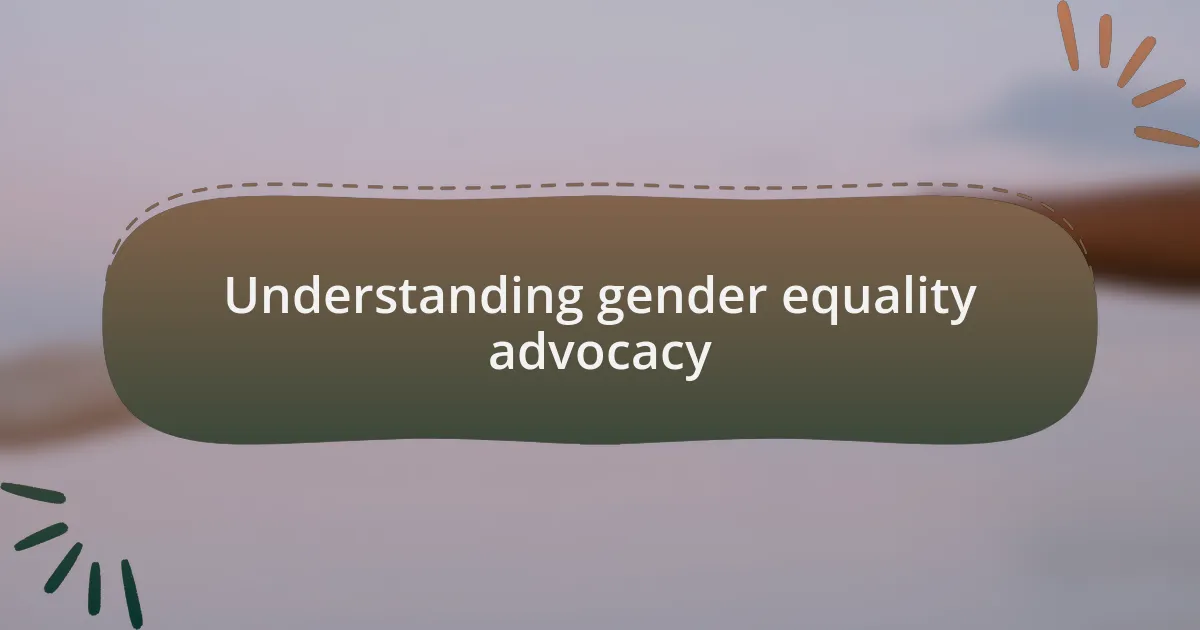
Understanding gender equality advocacy
Gender equality advocacy is more than just a concept; it’s a passionate commitment to creating a balanced society. I remember my first experience speaking at a local forum, where I noticed the disparity in representation. It struck me profoundly to see so few women sharing their voices, reminding me that advocacy is crucial for uplifting those who often go unheard.
When I think about gender equality, I can’t help but ask myself: how can we thrive as a society without equitable access to opportunities? This thought drives my advocacy efforts daily. The simple act of promoting equal rights isn’t just about policy changes; it’s also about challenging societal norms and dismantling barriers that perpetuate inequality.
Engaging with individuals who’ve experienced discrimination has deeply shaped my understanding of gender equality advocacy. Hearing their stories of resilience evokes both sadness and inspiration. It makes me realize that advocacy is an emotional journey, requiring empathy and a commitment to amplifying those voices that demand to be heard. What moves you to advocate for gender equality?
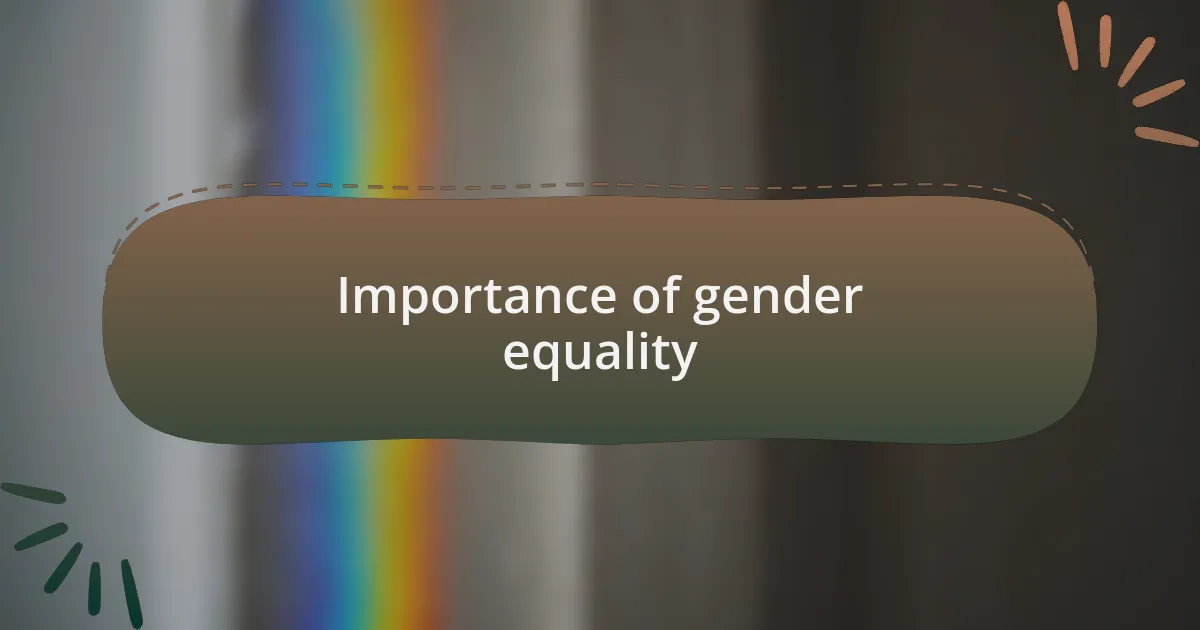
Importance of gender equality
Gender equality is crucial for social stability and growth. It’s surprising how often I encounter situations in conversations where the value of diverse perspectives is overlooked. For instance, in a project meeting, a woman’s unique viewpoint led to an innovation that no one expected. That’s the power of equality—it fosters creativity and efficiency.
Consider how gender equality impacts economic progress. I recall a discussion with a colleague about this very issue. She noted that empowering women to participate in the workforce can significantly increase a nation’s GDP. It makes me ponder: how much more could we achieve if we fully embraced this potential? The benefits are not just social; they are economic, affecting us all.
The significance of gender equality extends beyond mere numbers and statistics. It resonates on a human level, shaping lives and communities. I often find myself reflecting on the stories of young girls stifled by traditional roles. Their dreams and ambitions deserve to flourish. Isn’t it our responsibility to ensure everyone has the right to chase their aspirations freely?
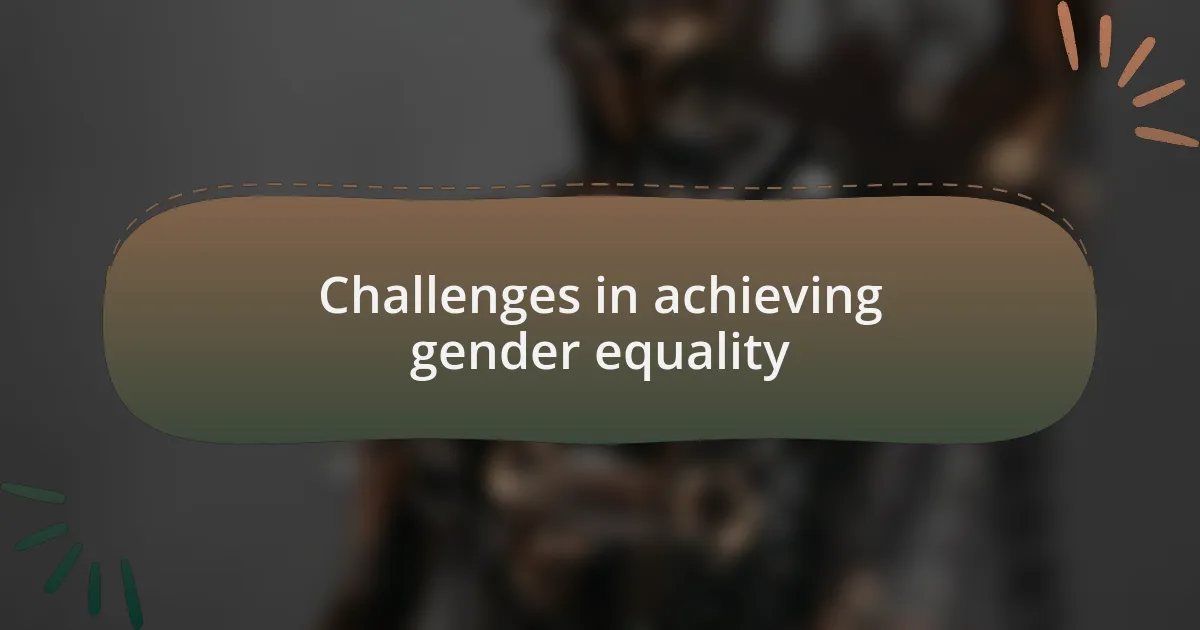
Challenges in achieving gender equality
When it comes to achieving gender equality, one significant challenge is the deep-rooted cultural norms that often dictate roles based on gender. I remember attending a community meeting where a local leader dismissed the idea of women in leadership, citing tradition. It struck me how these ingrained beliefs hinder progress, forcing talented individuals into boxes that limit their contributions. Isn’t it disheartening to realize how often potential is stifled by outdated views?
Another hurdle is the disparity in access to education and resources. During a recent conversation with a teacher in a rural area, she shared her frustrations about young girls being pulled from school to help at home. Hearing her passion for their futures made me reflect on what opportunities are being sacrificed every day. It’s not just about education; it’s about empowering the next generation to believe they can aspire for more.
Additionally, the lack of representation in decision-making roles presents a considerable obstacle. I’ve witnessed how boards and committees often lack diverse voices, leading to policies that overlook women’s needs. This absence not only skews priorities but also perpetuates the cycle of inequality. How can we expect lasting change when the very people affected by these issues are left out of the conversations that shape their lives?
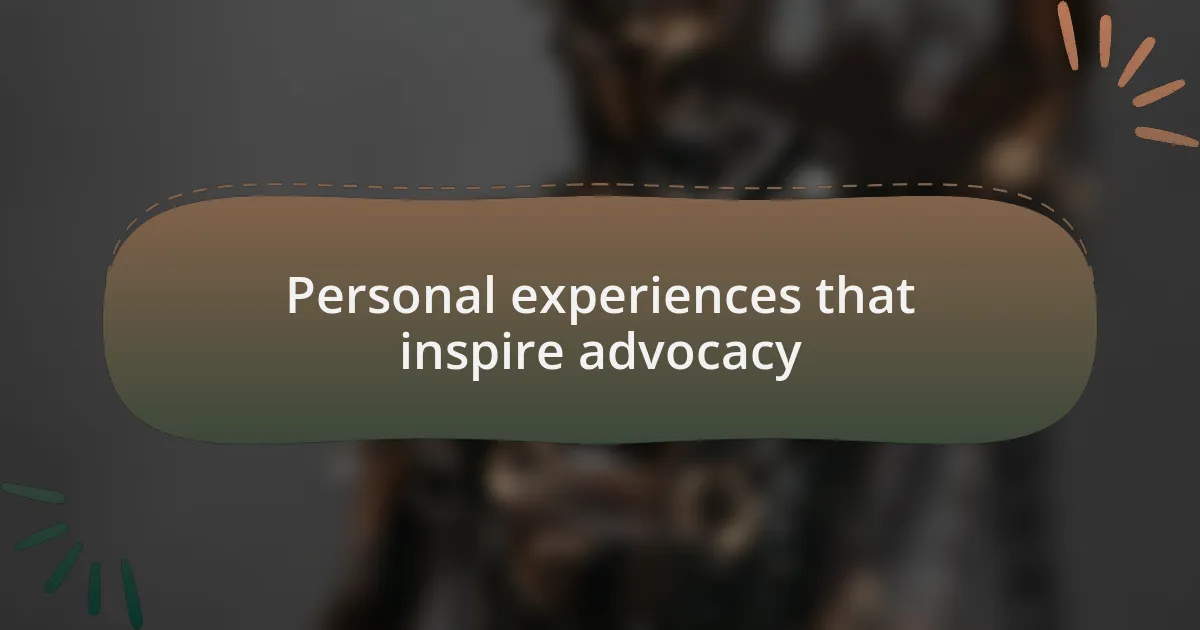
Personal experiences that inspire advocacy
The experiences that fuel my advocacy often stem from moments that catch me off guard. One time, while volunteering at a women’s shelter, I came across a mother who shared her dreams for her daughter’s future. As she spoke, I could see the hope in her eyes mixed with the fear of her circumstances. It made me think: how many dreams remain unrealized simply because of societal constraints?
I remember a powerful conversation with a friend who faced workplace harassment. Listening to her describe the toll it took on her mental health was a wake-up call. It underscored for me the urgent need to address not just the policies but the culture that allows such behavior to thrive. Isn’t it crucial to create environments where everyone feels safe to express themselves?
During a trip overseas, I observed how differently women were treated in public spaces, compared to what I was accustomed to. This juxtaposition wasn’t just an eye-opener; it stirred something deep within me. It prompted me to ask: what can I do to be a part of the solution? Those moments remind me that advocacy isn’t just about addressing issues; it’s about standing up for the dignity and rights of every individual.
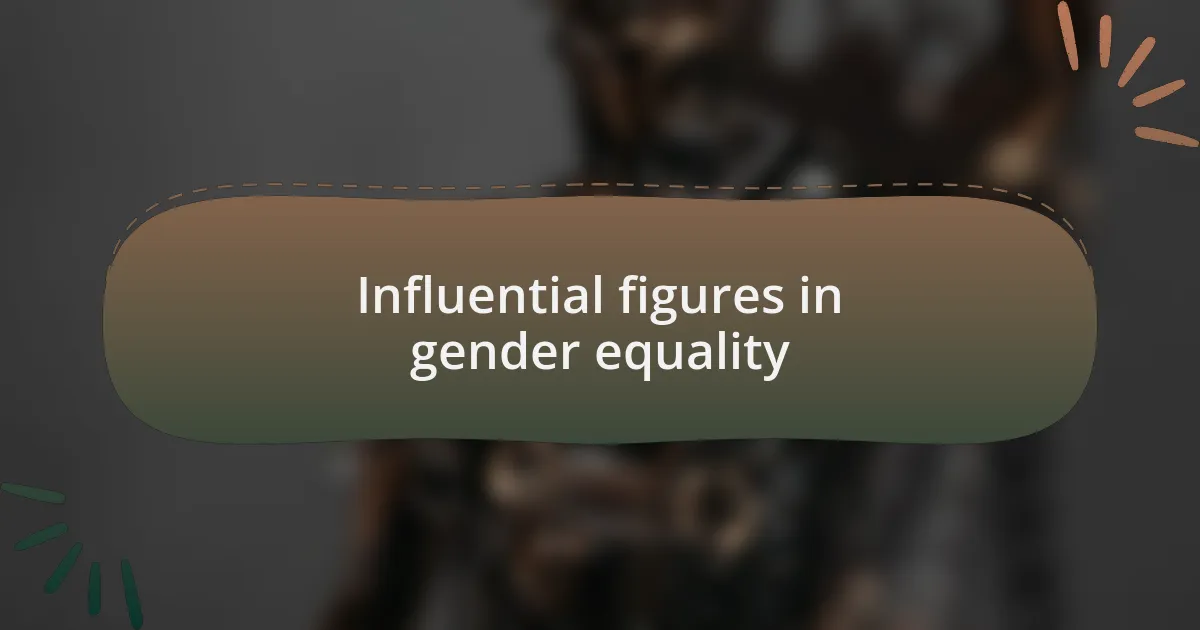
Influential figures in gender equality
There are many influential figures in gender equality who inspire me deeply. For instance, I can’t help but admire Malala Yousafzai. Her courageous advocacy for girls’ education in the face of extreme adversities speaks volumes about the importance of determination and hope. When I reflect on her journey, it makes me wonder: how can we each channel a fraction of her strength in our own communities?
Another figure that stands out to me is Ruth Bader Ginsburg. Her tireless fight for women’s rights within the legal system challenges us to think about the interconnectedness of law and equality. I remember reading about one of her Supreme Court cases, and it struck me how her words not only changed policies but also inspired countless women to pursue their own paths in law. Don’t we all have a responsibility to ensure that everyone has a seat at the table?
Then there’s Angela Merkel, who has exemplified strong leadership as a woman in a position often dominated by men. I once listened to a podcast where she spoke about navigating gender biases in politics; her insights reminded me of the subtle yet powerful barriers women face every day. It begs the question: how can we support one another to break down these barriers and forge a path toward equality?
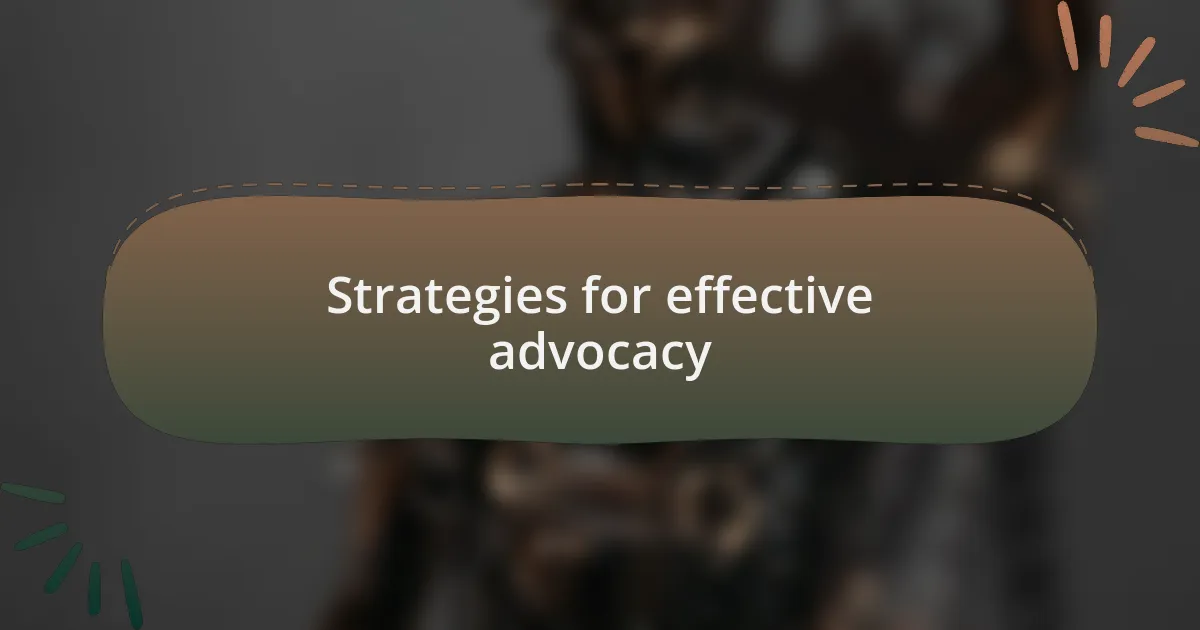
Strategies for effective advocacy
Effective advocacy begins with understanding the audience you want to reach. In my experience, tailoring messages to resonate with diverse groups has been pivotal. For instance, when I engaged with a local community about gender equality, I ensured that the conversation was anchored in their specific concerns and cultural context. This approach allowed the community to see gender equality as a shared goal rather than an external imposition. How can we utilize our own stories to connect with others on this journey?
Another powerful strategy is to form alliances with organizations that share similar ideals. When I collaborated with a women’s rights group for a campaign, we amplified each other’s efforts and resources. This collective strength was more impactful than anything I could have achieved alone, showcasing how pooling our voices can draw more attention to our cause. Have you ever considered how much more power lies in unity than in isolation?
Utilizing social media platforms effectively can also drive advocacy efforts significantly. I remember a time when a simple post I shared sparked a dialogue among my peers about workplace equality. The interactions that followed revealed a wealth of experiences and perspectives that enriched our understanding of the topic. What are the stories in your own life that could light the spark for change online?